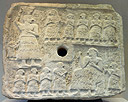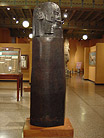Mesopotamia
Earliest Rulers
The first evidence for rulers in Mesopotamia (modern Iraq) comes from the southern alluvial plain where high civilization proper appears to have begun. Uruk (modern Warka in southern Iraq, located midway between Nasiriya and Samawah) was the first major urban center (4th millennium BCE), and archaeological and artistic evidence together with textual sources from later periods suggest that the ruler of that city—and, by extension, other cities in the region—was called en. This word in later texts means ‘lord.’ The position of en appears to have combined religious and political responsibilities; the en of Uruk was both a priest of the goddess Inana, acting as her spouse and taking part in the various rituals and festivals in her temple, and the caretaker of his people, ensuring that they were safe and well supplied with goods.
As cities grew in southern Mesopotamia, so did the need for protection from outside forces; city-states began vying with each other and struggling for hegemony. At around this time the position of en appears to have been relegated to a purely religious one and the political ruler came to be called ensi. Each city-state had an ensi who was responsible for the general well-being of his people. The ensi would pay tribute to the gods, particularly the patron deity of his city, commissioning the building of temples and divine statues and making pious donations to them. He was also the military leader in times of conflict.
Rise of Kingship
When the southern and northern parts of Southern Mesopotamia—called, respectively, Sumer and Akkad—were united, the role of the ruler changed somewhat. He was now called lugal, which literally means ‘big man,’ but which we translate as ‘king.’ Many scholars believe that this kind of rulership, which was more authoritarian and more concerned with military conquests than the typical ensi had been, was a northern import from Akkad, but was integrated into the culture almost seamlessly, partly owing to the clever diplomacy of the Akkadian kings, but also, no doubt, because Sumer and Akkad shared many customs, having had a long relationship.
The kings of the first Dynasty of Akkad—so called because they came from the northern part of Southern Mesopotamia, called Akkad—beginning with Sargon the Great, made the first attempts to create an empire. They concentrated their efforts on conquering far-flung lands and both wrote about their conquests in monumental inscriptions and depicted themselves as victorious over their enemies in monumental art. And the Akkadian kings did something that had never been done before in Mesopotamia: they deified themselves. Sargon’s grandson, Naram-Sin, was the first ruler to have his name written with the designation god (dingir) in front of his name, signaling that he himself was divine. But after the third millennium BCE, this tradition does not appear to have continued with any regularity.
Rise of a Nation
With the rise of the Amorites (a group from the West) to rulership, specifically Hammurabi, the nature of kingship remained for the most part the same while the political landscape of the country changed with the previously unimportant city of Babylon becoming the political capital of Babylonia. Babylon remained the capital throughout the rest of Mesopotamia’s history, witnessing non-native rule by the Kassites and later by the Chaldeans, all of whom assimilated and were accepted into Mesopotamian culture and continued its traditions.
One of those traditions was competing with its northern neighbor, the nation of Assyria. Assyria shared many cultural and religious beliefs with Babylonia, but was also quite distinct. Archaeological finds revealing palace architecture have shown that Assyrian kings withdrew more and more from public view as the role of king grew more powerful.

 Jennie Myers
Jennie Myers
Research Associate, University of Chicago
Guiding Questions
1. How did the role of the ruler change in Mesopotamia?
2. In what ways were the roles of Egyptian and Mesopotamian rulers similar? What made them distinct?
3. What are some similarities between the justice systems of Egypt and Mesopotamia, and that of the United States?


 Print Page
Print Page



